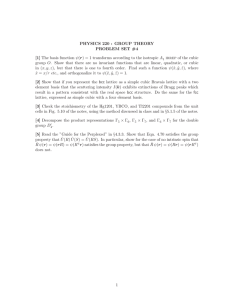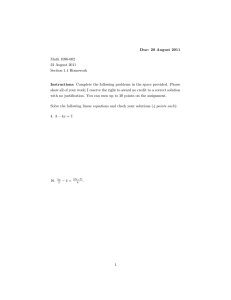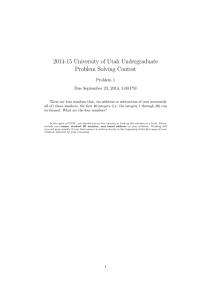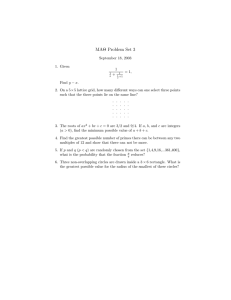Document 13644617
advertisement
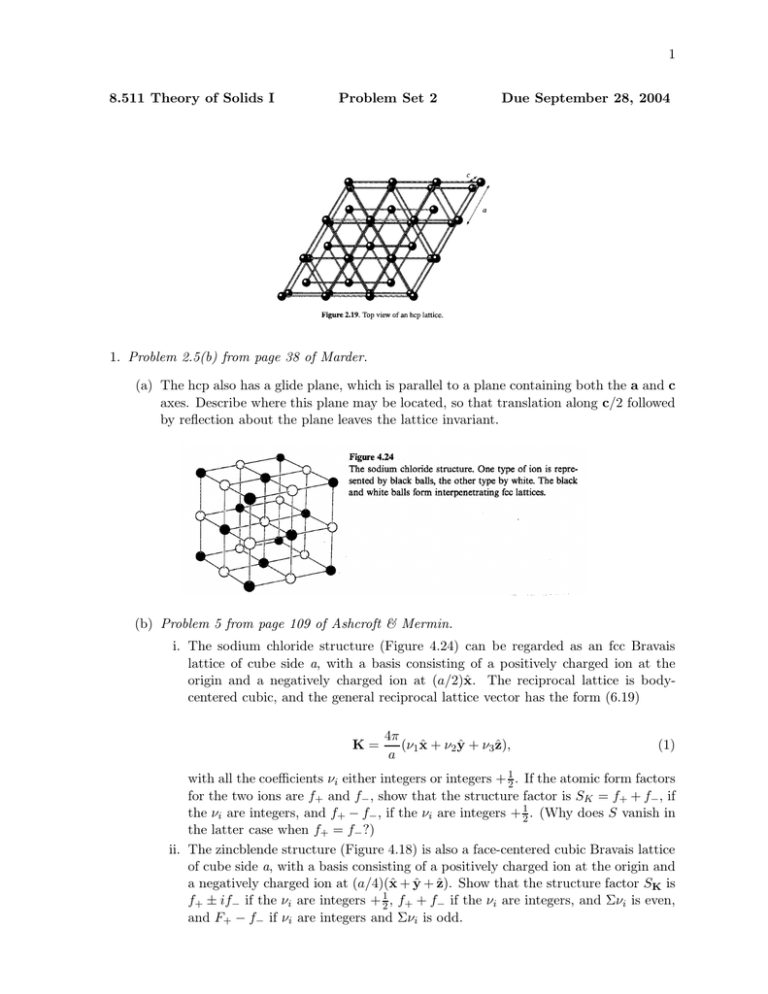
1 8.511 Theory of Solids I Problem Set 2 Due September 28, 2004 1. Problem 2.5(b) from page 38 of Marder. (a) The hcp also has a glide plane, which is parallel to a plane containing both the a and c axes. Describe where this plane may be located, so that translation along c/2 followed by reflection about the plane leaves the lattice invariant. (b) Problem 5 from page 109 of Ashcroft & Mermin. i. The sodium chloride structure (Figure 4.24) can be regarded as an fcc Bravais lattice of cube side a, with a basis consisting of a positively charged ion at the origin and a negatively charged ion at (a/2)x̂. The reciprocal lattice is bodycentered cubic, and the general reciprocal lattice vector has the form (6.19) K= 4π ˆ + ν3 ˆz), ˆ + ν2 y (ν1 x a (1) with all the coefficients νi either integers or integers + 21 . If the atomic form factors for the two ions are f+ and f− , show that the structure factor is SK = f+ + f− , if the νi are integers, and f+ − f− , if the νi are integers + 21 . (Why does S vanish in the latter case when f+ = f− ?) ii. The zincblende structure (Figure 4.18) is also a face-centered cubic Bravais lattice of cube side a, with a basis consisting of a positively charged ion at the origin and ˆ + ˆz). Show that the structure factor SK is x+y a negatively charged ion at (a/4)(ˆ 1 f+ ± if− if the νi are integers + 2 , f+ + f− if the νi are integers, and Σνi is even, and F+ − f− if νi are integers and Σνi is odd. 2 iii. Suppose that a cubic crystal is known to be composed of closed-shell (and hence spherically symmetric) ions, so that f± (K) depends only on the magnitude of K. The positions of the Bragg peaks reveal that the Bravais lattice is face-centered cubic. Discuss how one might determine, from the structure factors associated with the Bragg peaks, whether the crystal structure was likely to be of the sodium chloride or zincblende type. 2. Problem 3 from page 171 of Ashcroft & Mermin. Effect of Weak Periodic Potential at Places in k-Space where Bragg Planes Meet. Consider the point W(kw = (2π/a)(1, 21 , 0)) in the Brillouin zone of the fcc structure shown (see Fig. 9.14). Here three Bragg planes ( (200), (111), (111̄) ) meet, and accordingly the free electron energies �2 2 k , 2m � �2 k− ε02 = 2m � �2 k− ε03 = 2m � �2 ε04 = k− 2m ε01 = �2 2π (1, 1, 1) , a �2 2π (1, 1, 1̄) , a �2 2π (2, 0, 0) , a (2) are degenerate when k = kw , and equal to εw = �2 k2w /2m. (a) Show that in a region of k space near W, the first-order energies are given by solutions 3 to [1] ε01 − ε U1 U1 U2 U1 ε02 − ε U2 U1 U1 U2 ε03 U2 U1 U1 =0 − ε U1 ε4 0 − ε where U2 = U200 , U1 = U111 = U 11¯ 1, and that at W the roots are ε = εw − U2 (twice), ε = εw + U2 ± 2U1 . (3) (b) Using a similar method, show that the energies at the point U (kU = (2π/a)(1, 41 , 14 ) ) are 1 ε = εU − U2 , ε = εU + U2 ± (U2 2 + 8U12 )1/2 2 where εU = �2 k2 U /2m. [1] Assume that the periodic potential U has inversion symmetry so that the Uk are real. (4)
